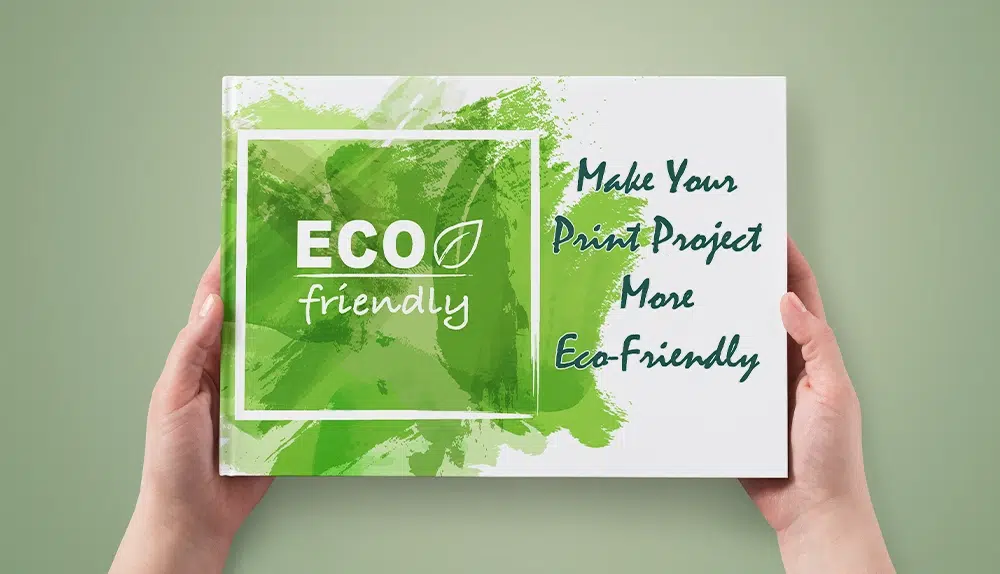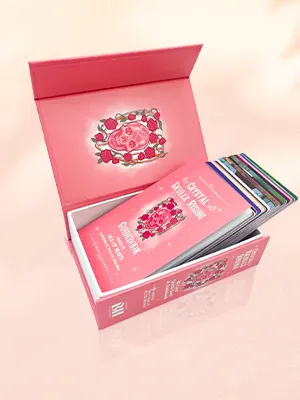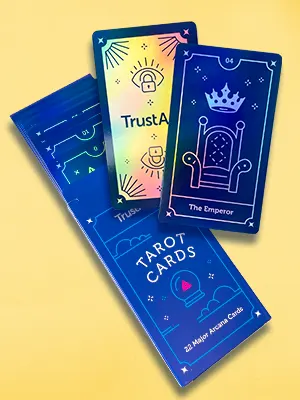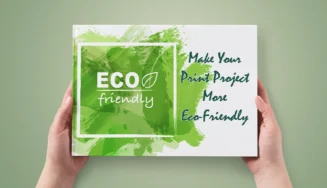Whether you're printing books, packaging products, or creating promotional materials, sustainability is now a key concern for businesses and consumers alike.

As smart businesses who want to stay ahead of the game know, eco-friendly printing isn't just better for the planet—it can also boost your brand's image and appeal to the preferences of environmentally conscious consumers. Here, we'll explore straightforward yet highly effective ways you can make your print projects greener without compromising quality or blowing your budget.
What is eco-friendly printing?
Eco-friendly printing means more than just using recycled paper—although that's an excellent start. It involves considering every stage of your print project's lifecycle, from material sourcing and production methods to shipping and recycling options. So, as here at QinPrinting we are determined to continue to work towards making our business as sustainable as possible and encouraging our clients to do the same, let's dive a little deeper into practical steps you can implement today when you work with us.
1. Choose eco-friendly materials
The first and simplest step toward sustainability is selecting environmentally responsible materials. At QinPrinting, we've developed excellent sources of recycled, recyclable, and biodegradable materials of the highest quality to offer our customers. Here's an insight into some of that:
- Recycled paper: Opt for paper certified by FSC (Forest Stewardship Council) or containing a high percentage of post-consumer recycled content. We're proud of our FSC certification and we have authorization to add the FSC logo to your products if you use a sufficient percentage of these materials.
- Kraft paper: Kraft paper is naturally biodegradable, recyclable, and made from sustainable resources, making it an excellent choice for eco-friendly packaging. And while it commonly gets associated with the “handmade” look, these days it comes in a variety of slick finishes including smooth, white, and black, too.
- Soy or vegetable-based Inks: Unlike petroleum-based inks which have high levels of toxic volatile compounds, our comprehensive range of soy inks are derived from renewable resources, reduce air pollution, protect water quality, and enhance recyclability. And the colors are gorgeous, vibrant, we think better than older solvent-based inks.
2. Minimize waste through design
Materials are only the beginning, however. What you do with them can have a huge impact on sustainability and responsible resources management. For example, efficient design can significantly reduce waste:
- Compact layouts: Optimize your designs to use space fully and efficiently, reducing excess paper. This approach can make your products and packaging more robust, reduce literally tons of waste, and reduce costs, too. What's not to love?
- Standard dimensions: When you're designing, remember that we hold in stock a range of most-commonly used paper sizes for various projects such as books, cards, and boxes. Stick to standard paper sizes and formats and you'll minimize offcuts and waste.
- Minimalist designs: Simple designs with fewer ink-intensive images or colors decrease ink usage and the environmental impact of production. It's also often the best result in terms of impact, too. In marketing design, less is almost always more.
3. Sustainable packaging solutions
Packaging often contributes significantly to environmental waste, but making more thoughtful choices can mitigate this to a significant degree:
- Reusable packaging: Consider boxes and packaging that consumers can repurpose, such as sturdy magnetic boxes or kraft boxes. You'll be surprised how keen most customers are to hold on to and reuse a really beautiful box; especially if you suggest it to them!
- Recyclable and compostable options: We're working hard to increase our stocks of packaging materials that are easily recyclable or compostable to guarantee minimal environmental impact. Almost all our materials, even some of the plastics, are recyclable now and we're actively developing more compostable options, too.
- Reducing packaging weight: Lightweight packaging reduces transportation emissions, which in turn makes your supply chain more sustainable. Don't underestimate the cumulative power of these ideas, especially if you often ship goods overseas.
4. Environmentally friendly production processes
The manufacturing phase, which happens in our state-of-the-art facilities in Shanghai, is another vital element in determining how eco-friendly your project will be:
- Offset printing: Offset printing—which is what we do—is highly efficient for large print runs, producing high-quality results with minimal waste and energy consumption when managed correctly.
- Water-based coatings: Choose water-based finishes rather than UV or plastic-based coatings, as they're less harmful to the environment and easier to recycle.
- Responsible manufacturing partners: You can get greener just by choosing a company—like QinPrinting—that clearly demonstrates a genuine commitment sustainable practices, such as appropriate certification, energy efficiency, recycling programs, and responsible waste management.
5. Efficient and greener shipping
Transportation contributes significantly to your project's carbon footprint. And you might be especially concerned about this if you have either inbound or outbound shipping that crosses international borders. But there are simple, practical ways that you can mitigate the carbon footprint of international shipping. So, you can lower this impact by:
- Bulk orders and smart shipping: Large bulk orders shipped using energy-efficient logistics methods can greatly reduce emissions—and costs—per unit, even when shipping internationally. While it takes a little longer, opting for shipping by sea rather than air will reduce your emissions considerably.
- Eco-friendly shipping partners: Partner with logistics providers who commit to carbon offsetting and environmentally friendly practices. For example, at QinPrinting, our shipping partners are FedEx who have a commitment to long-term sustainability and carbon neutrality, including a $2bn initial investment in electric vehicles, carbon sequestration, and sustainable energy sourcing; and DHL who have a carbon neutral target approved by the Science-Based Targets initiative (SBTi) which includes sustainable aviation fuels, electrification, and carbon neutral buildings.
While local printing might be suitable for small domestic print orders, international printing, combined with efficient shipping strategies and environmentally committed partners, can offset the impact of long-distance transit, especially for bulk business orders.
6. Communicate your eco-friendly practices
Transparency enhances customer trust and brand loyalty. And if you're going the extra mile to green-up your act, then don't hide your light under a bushel. Clearly communicate your sustainability efforts to your clients and customers in the following ways:
- Eco labels and certifications: Highlight your certifications like FSC, recycled content percentage, and eco-friendly inks on your packaging and marketing materials. We are authorized by the FSC to print the certification logo on products we make which are made from sustainably sourced materials, for example.
- Sustainability statements: Include concise messages about your environmental commitments on packaging or on your website. And don't “green wash”, tell the truth. Few businesses can become carbon neutral overnight. Be honest about your targets and how you are working toward achieving them.
At-a-Glance Summary
| Eco-Friendly Strategy | Key Benefits |
|---|---|
| Use recycled or kraft paper | Use recycled or kraft paper Reduces environmental impact; enhances brand image |
| Soy or vegetable-based inks | Renewable, reduces pollution, improves recycling |
| Minimize waste in design | Saves resources, lowers costs |
| Sustainable packaging | Reduces landfill waste, appeals to consumers |
| Eco-friendly production | Decreases harmful emissions and waste |
| Efficient shipping practices | Reduces carbon footprint, saves costs |
| Transparent communication | Builds consumer trust, boosts brand loyalty |
Frequently Asked Questions (FAQs)
1. Is recycled paper lower quality than regular paper?
No. Modern recycled paper often matches the quality of non-recycled paper, offering excellent print results suitable for most applications.
2. Are vegetable-based inks as durable as petroleum-based inks?
Yes, soy or vegetable-based inks provide comparable durability and vivid colors while being significantly better for the environment.
3. How can minimalist designs help the environment?
Minimalist designs use fewer resources—less ink and paper—and simplify recycling, making them an excellent sustainable choice.
4. What makes kraft paper environmentally friendly?
Kraft paper is biodegradable, recyclable, sourced sustainably, and its production involves fewer harmful chemicals than standard paper.
5. Does eco-friendly printing cost more?
Initially, some eco-friendly options may have higher upfront costs, but efficiency savings and improved brand reputation often offset these costs long-term.
6. How can I make sure my packaging is truly recyclable?
Choose single-material packaging, clearly label recycling instructions, and avoid complex, layered materials that complicate recycling processes.
7. Is offset printing eco-friendly?
Yes. Offset printing is highly eco-friendly for large-scale projects due to its efficiency, reduced waste per unit, and high-quality results.
Talk to us. We can help!
Making your print projects eco-friendly isn't merely beneficial for the environment—it also strengthens your brand reputation, meets growing consumer expectations, and can lead to long-term cost savings. With the practical steps outlined here, you can implement more sustainable practices into your printing processes, benefiting both your business and the planet.
If you need any further help or advice on how to work with us to make your project more environmentally friendly, we're here to help you every step of the way from concept to completion. Contact us now for expert guidance and high-quality design, manufacture, and shipping options tailored to your specific needs. Just shoot us an email to [email protected] or call us on +1 530 238 5010 and we'll be delighted to do all we can to help you.






